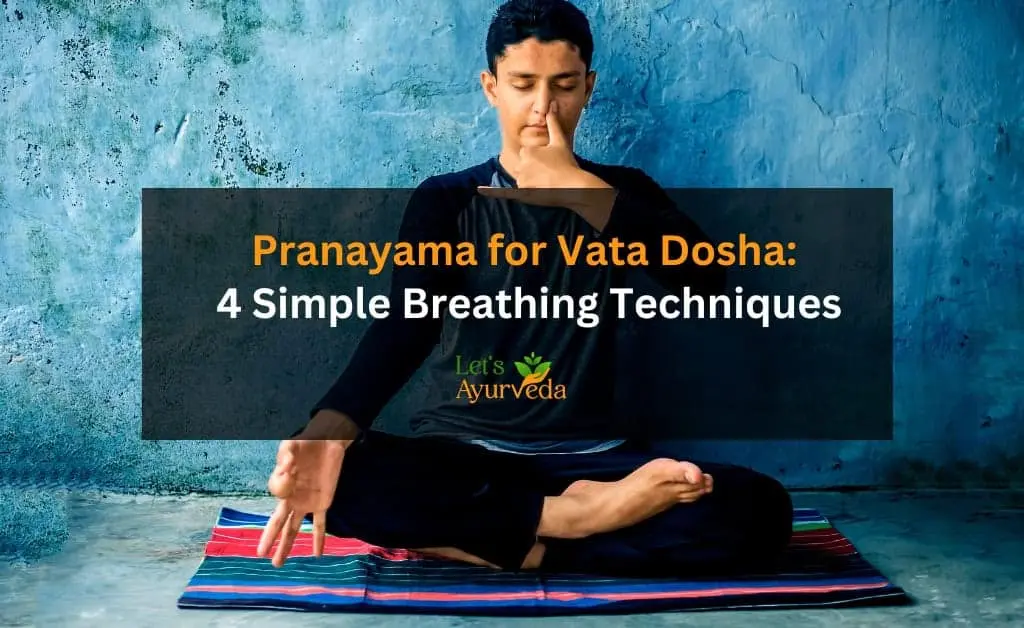Introduction
Do you often feel restless, anxious, or like your mind is running a mile a minute? These might be signs that your Vata dosha is out of balance. According to Ayurveda, Vata governs movement, creativity, and communication, but when it's disturbed, it can lead to stress, insomnia, and digestive issues. The good news? Pranayama, or controlled breathing techniques, can help restore balance.
In this blog, we’ll explore how specific pranayama techniques can calm Vata dosha and improve your overall well-being. Let’s dive in.
What Happens When Vata Dosha Is Imbalanced?
Vata dosha is one of the three primary doshas in Ayurveda, governing motion, energy, and the nervous system. When in balance, it contributes to clarity, vitality, and creativity. But when Vata becomes aggravated, it can throw your entire system out of sync.
Common Symptoms of Vata Imbalance:
-
Anxiety and restlessness
-
Irregular digestion (bloating, constipation)
-
Dry skin and brittle hair
-
Difficulty sleeping
-
Lack of focus and forgetfulness
If left unchecked, these symptoms can affect your mental, emotional, and physical health. This is where pranayama comes into play as a powerful tool to bring Vata back into harmony.
The Effects of Ignoring Vata Imbalance
When Vata dosha is aggravated, the body becomes more prone to quick depletion of energy. Your digestion weakens, leading to toxins building up in your system. Over time, this imbalance may turn into chronic conditions like joint pain, fatigue, and even anxiety disorders.
Worse yet, the overstimulation of Vata can leave you feeling like you’re stuck in a loop of never-ending stress and burnout. These imbalances can disrupt your sleep, leaving you tired, moody, and unable to focus during the day. Many people even report feeling a lack of purpose or direction when Vata is out of balance.
Ignoring these symptoms can have long-term consequences on your health. But instead of reaching for a quick fix, pranayama offers a natural solution to calm the mind and body, restoring balance to your Vata.
Pranayama for Balancing Vata Dosha
The practice of pranayama, or breath control, can directly influence the Vata dosha, helping you slow down and re-establish calmness. Here’s how it works:
How Pranayama Balances Vata:
-
Regulates the Nervous System: Vata is closely linked to the nervous system. Controlled breathing calms the fight-or-flight response, reducing anxiety and promoting relaxation.
-
Grounds the Mind and Body: Pranayama promotes mindfulness, which is essential for stabilizing Vata’s scattered energy.
-
Improves Digestion: Certain breathing techniques enhance digestion by improving circulation and stimulating digestive fire (Agni).
-
Promotes Deep Rest: Pranayama helps you achieve deeper, more restful sleep, which is crucial for calming Vata.
Let’s explore specific pranayama techniques designed to pacify Vata dosha.
1. Nadi Shodhana (Alternate Nostril Breathing)
This pranayama technique balances both hemispheres of the brain and calms the nervous system, making it ideal for pacifying Vata dosha. Nadi Shodhana focuses on smooth, controlled breathing through alternate nostrils, which balances Vata’s natural restlessness.
How to Practice:
-
Sit comfortably with your spine straight.
-
Close your right nostril with your thumb, inhale through the left nostril.
-
Close your left nostril with your ring finger, exhale through the right nostril.
-
Inhale through the right, close it, and exhale through the left.
-
Repeat this cycle for 5-10 minutes.
Benefits for Vata:
-
Calms the mind and relieves stress
-
Regulates nervous system activity
-
Reduces anxiety and promotes mental clarity
2. Ujjayi Pranayama (Victorious Breath)
Ujjayi is a warming, calming breath that mimics the ocean’s sound, providing a sense of peace and grounding to Vata dosha. This technique promotes oxygenation, improves focus, and helps bring warmth to the often cold, dry nature of Vata.
How to Practice:
-
Sit comfortably and inhale deeply through your nose.
-
As you exhale, constrict the back of your throat, creating a soft hissing sound.
-
Focus on the sound of your breath, and continue for 5-7 minutes.
Benefits for Vata:
-
Creates warmth in the body, which is essential for Vata
-
Promotes mental focus and relaxation
-
Improves sleep quality
3. Bhramari Pranayama (Bee Breath)
Bhramari pranayama is perfect for calming a busy mind. The humming sound produced during this breathing technique soothes the nervous system and brings immediate relief from Vata-related stress and anxiety.
How to Practice:
-
Sit in a comfortable position.
-
Inhale deeply through the nose.
-
Close your ears with your thumbs and gently place your fingers on your eyes.
-
Exhale slowly while making a humming sound, like a bee.
-
Repeat for 5-7 rounds.
Benefits for Vata:
-
Quickly calms the mind and nervous system
-
Relieves headaches, stress, and anxiety
-
Grounds scattered thoughts and emotions
4. Sheetali Pranayama (Cooling Breath)
Although Vata types often prefer warming techniques, Sheetali pranayama can be used to cool down the body when there is excess heat or agitation. It helps balance Vata by soothing the mind and providing relief from overstimulation.
How to Practice:
-
Sit comfortably with your spine straight.
-
Roll your tongue into a tube and inhale through the mouth.
-
Close your mouth and exhale through your nose.
-
Repeat for 5-10 rounds.
Benefits for Vata:
-
Soothes mental agitation and restlessness
-
Calms the mind during stress or emotional upset
-
Relieves digestive discomforts
Practical Tips to Incorporate Pranayama into Your Routine
Pranayama is most effective when practiced daily. Start with 5-10 minutes of breathing exercises in the morning or before bed. Pair it with grounding activities such as yoga, meditation, or even a simple walk in nature.
-
Morning Routine: Begin your day with Nadi Shodhana to center your mind and body.
-
Before Bed: Practice Ujjayi or Bhramari to relax and calm your nervous system for restful sleep.
-
During Stress: Sheetali can be used as a quick fix to cool your emotions during high-stress moments.
Why Pranayama Is Essential for Vata Balance
Pranayama is an accessible, powerful tool to bring balance to Vata dosha. Whether you’re dealing with anxiety, digestive issues, or mental overload, controlled breathing can help calm the storm. By incorporating these simple techniques into your routine, you can restore balance, improve your health, and live in harmony with your dosha.
So why wait? Start your pranayama practice today and bring peace to your mind and body.






